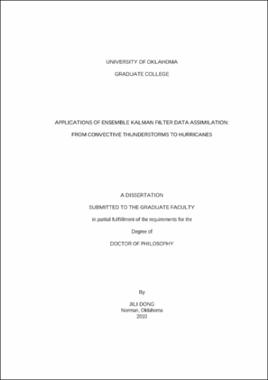| dc.contributor.advisor | Xue, Ming | |
| dc.creator | Dong, Jili | |
| dc.date.accessioned | 2019-04-27T21:25:01Z | |
| dc.date.available | 2019-04-27T21:25:01Z | |
| dc.date.issued | 2010 | |
| dc.identifier | 99170909502042 | |
| dc.identifier.uri | https://hdl.handle.net/11244/318633 | |
| dc.description.abstract | For the numerical prediction of severe thunderstorm and hurricane, data assimilation is one of the necessary tools to obtain accurate initial conditions. Ensemble Kalman filter (EnKF) is a state of the art data assimilation algorithm, with the advantage of using flow-dependent error covariance information and retrieving unobserved model quantities. In this dissertation, EnKF is first employed to assimilate additional surface observation in the presence of radar data for severe thunderstorm analysis and prediction with Observing System Simulation Experiments (OSSEs). The EnKF is then used to assimilate real coastal WSR-88D radar observations for Hurricane Ike (2008), and the impact of radar data on the analysis and forecast is investigated. | |
| dc.description.abstract | Due to the earth curvature effect and the non-zero elevation of the lowest scan of ground-based radars, low-level coverage of radar data decreases as distance from the radar increases, causing loss of coverage for important low-level features including the cold pool and gust front. Observations from surface networks are expected to help fill such low-level data gaps. To investigate the impact of additional surface observations on the analysis and forecast of convective storms, a series of OSSEs are performed using the ARPS model and its EnKF data assimilation system. | |
| dc.description.abstract | When the radar is located at a significant distance (e.g., the 115 and 185 km distances considered) from the main convective storm, a clear positive impact on the storm analysis and forecast is achieved by assimilating surface observations with a spacing of about 20 km. When the radar is located just 45 km from the storm center, a network spacing of 6 km is needed to achieve any noticeable positive impact. The impact of surface data in terms of relative error reduction increases linearly with decreased surface network spacing until the spacing is close to the grid interval of truth simulation. Assimilating observations from a coarser network over a longer period of time helps to achieve a similar level of impact as would be seen from a network of higher density. | |
| dc.description.abstract | The error correlation fields derived from the forecast ensemble exhibit dynamically consistent structures. Through flow-dependent error covariance and dynamical interactions in the prediction model, the surface observations not only correct the surface errors, but also improve analyses of state variables at the mid- and upper levels. Given typical observation error, surface wind observations produce the largest positive impact, followed by temperature measurements. Pressure measurements produce the least impact. Assimilating all surface observation variables together yields the largest impact. | |
| dc.description.abstract | The impact of surface data is sustained or even amplified during subsequent forecasts when their impact on the analysis is significant. | |
| dc.description.abstract | In the second part of this dissertation, EnKF assimilation and forecasting experiments are performed for the case of Hurricane Ike (2008), the third most destructive hurricane hitting the United States. Data from two coastal WSR-88D radars were carefully quality controlled, including automatic and manual velocity dealiasing. For the control experiment, 32 ensemble members are used in the EnKF system, and reflectivity (Z) and radial velocity (Vr) data from the two coastal radars are assimilated at 10-minute intervals over a 2-hour period shortly before Ike made landfall. | |
| dc.description.abstract | Compared to the corresponding NCEP GFS analysis, the assimilation resulted in a much improved vortex intensity at the final analysis time, although it is still weaker than observed. Compared to the forecast starting from GFS analysis at the same initial time, the forecast intensity, track and structure of Ike over a 12 hour period are improved in both deterministic and ensemble mean forecasts. The ensemble spread is well maintained with the help of multiplicative covariance inflation and posterior additive perturbations during the assimilation cycles. Assimilation of either Vr or Z alone leads to improvement in hurricane intensity, track and quantitative precipitation forecast. Vr leads to more improvement in intensity and track forecast, emphasizing more importance of Vr data. Ensemble forecast has shown uncertainty growth in track forecast but not in intensity forecast. 30-minute assimilation interval has the similar results with 10-minute assimilation interval and 60-minute assimilation interval shows weaker intensity forecast. | |
| dc.description.abstract | Assimilation of additional minimum mean sea level pressure from best track data together with Z leads to further improvement in intensity and track forecast compared to assimilating Z alone. Assimilating minimum sea level pressure in addition to Vr leads to track forecast improvement but only small improvement in intensity analysis and forecast. | |
| dc.format.extent | 224 pages | |
| dc.format.medium | application.pdf | |
| dc.language | en_US | |
| dc.relation.requires | Adobe Acrobat Reader | |
| dc.subject | Numerical weather forecasting | |
| dc.subject | Kalman filtering | |
| dc.subject | Radar meteorology | |
| dc.subject | Thunderstorm forecasting | |
| dc.subject | Hurricanes--Forecasting | |
| dc.title | APPLICATIONS OF ENSEMBLE KALMAN FILTER DATA ASSIMILATION: FROM CONVECTIVE THUNDERSTORMS TO HURRICANES | |
| dc.type | text | |
| dc.type | document | |
| dc.thesis.degree | Ph.D. | |
| ou.group | College of Atmospheric & Geographic Sciences::School of Meteorology | |
